Crystalline specimens require specialized photography tools due to their unique optical properties that standard equipment can’t capture. You’ll need macro lenses (60-105mm) to reveal intricate structures, polarizing filters to display hidden features, and precise lighting setups to highlight translucency. Dark backgrounds enhance contrast while focus stacking overcomes the challenge of capturing multiple facets. These techniques let you document both scientific accuracy and aesthetic beauty in these complex, light-refracting subjects. The right tools unveil a crystal’s hidden world.
Numeric List of 9 Second-Level Headings
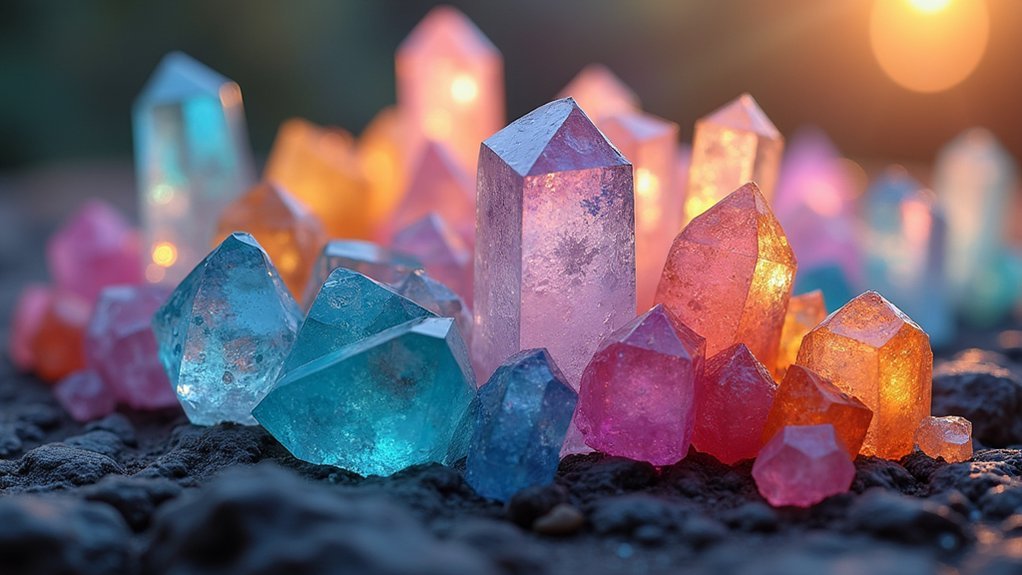
Nine essential categories form the foundation of specialized crystalline photography. As you develop your mineral photography skills, you’ll need to master these key areas:
- Macro lens selection
- Specialized lighting systems
- Polarization equipment
- Focus stacking hardware
- Vibration reduction tools
- Background and staging materials
- Color calibration instruments
- Image processing software
- Specimen preparation supplies
Each category addresses specific challenges in capturing crystalline details with best quality results. Your macro lenses must provide exceptional clarity for intricate structures, while specialized lighting reveals translucency that standard equipment misses.
Specialized equipment isn’t optional—it’s fundamental to revealing the hidden beauty in crystalline structures that ordinary gear simply cannot capture.
Polarizing filters reveal vibrant colors otherwise invisible, and stability tools prevent the micro-movements that ruin detail work. When combined with advanced editing techniques, these tools transform ordinary mineral photography into stunning scientific documentation that accurately represents crystalline specimens’ true beauty and complexity.
The Unique Optical Properties of Crystalline Structures
When photographing crystals, you’ll face significant challenges from light refraction that can distort their true appearance and colors.
Each crystal’s multiple facets create complex optical pathways that require careful consideration of lighting angles and intensities to properly document.
You’ll need to develop strategies for capturing these multi-facet complexities without creating overwhelming reflections or losing the subtle internal features that make each specimen unique.
Light Refraction Challenges
Crystalline specimens present photographers with extraordinary optical challenges that demand specialized techniques and equipment.
When you’re trying to capture the true essence of crystals, you’ll encounter complex light refraction patterns that standard photography methods simply can’t handle.
- Your camera must address color fidelity issues caused by varying refractive indices in different parts of the crystal.
- You’ll need polarizing filters to control unwanted reflections and enhance the natural optical properties.
- Achieving adequate depth of field becomes problematic as light bends differently throughout translucent specimens.
- Focus stacking techniques become essential to maintain sharpness across the varying depths of the crystal.
These challenges require specialized tools that can manipulate light precisely, allowing you to reveal the intricate beauty hidden within crystalline structures.
Multi-Facet Imaging Complexities
Unlike conventional subjects, multi-faceted crystals challenge photographers through their complex optical properties that transform light in mesmerizing yet technically demanding ways.
When you’re capturing crystalline specimens, you’ll quickly discover that standard photography techniques fall short. The varying refractive indices of crystals require precise positioning and lighting angles to reveal their true character.
You’ll need to employ focus stacking techniques to overcome the shallow depth of field that would otherwise leave critical facets blurred. This multi-facet imaging approach is essential for documenting the complete crystalline structure.
Without specialized macro lenses and polarizing filters, you simply can’t resolve the minute details that define mineralogical specimens. These tools aren’t luxury items—they’re necessities for achieving the overall quality required to accurately represent these complex natural wonders.
Essential Camera Equipment for Capturing Crystal Detail
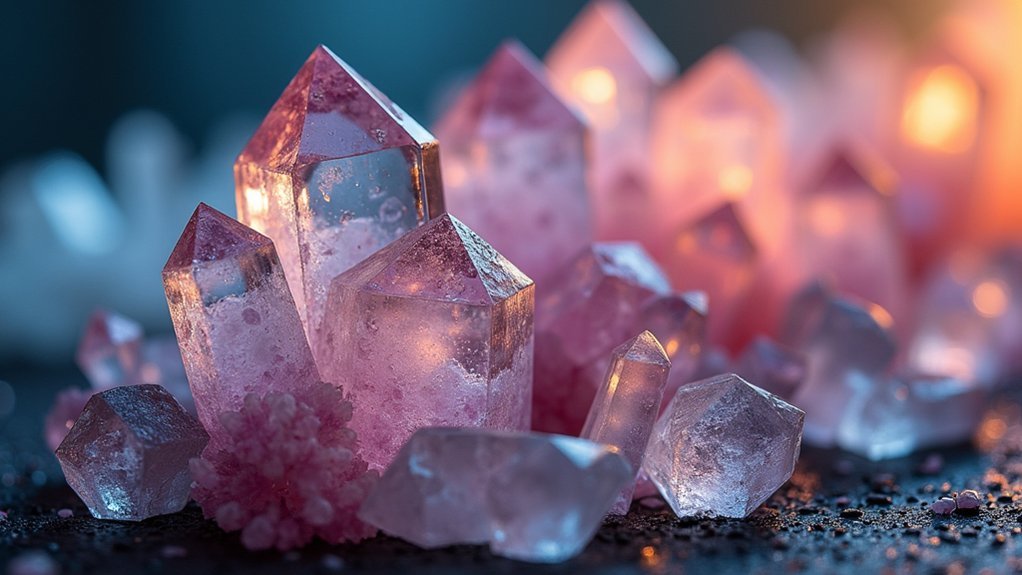
You’ll need top-quality macro lenses to reveal the intricate details of crystalline specimens, as these specialized optics bring out textures and patterns invisible to standard equipment.
Your tripod setup must effectively eliminate vibrations that could blur fine crystal structures during extended exposure times.
When choosing camera accessories, prioritize stability components and high-resolution macro capabilities to capture the subtle light interactions that make crystal photography so compelling.
Macro Lenses Matter
The secret weapon in crystal photography sits at the front of every mineral photographer’s camera—a quality macro lens.
When you’re capturing crystalline specimens, standard lenses simply can’t reveal the intricate details that make each crystal unique.
A dedicated macro lens offering 1:1 magnification ratio transforms your photography by:
- Providing sharp focus on minute features at close distances
- Maintaining ideal sharpness at midrange f-stops (f/8-f/11)
- Preserving original resolution by eliminating the need for cropping
- Enhancing translucency and color fidelity when paired with proper lighting
You’ll find that investing in a quality macro lens, rather than relying on zoom lenses, delivers superior clarity and detail.
This specialized tool isn’t just a luxury—it’s essential for accurately showcasing the textures, structures, and scientific properties of your crystalline subjects.
Vibration Control Essentials
When shooting crystal specimens at high magnification, even the slightest vibration can transform a potentially stunning image into a blurry disappointment. To achieve the highest resolution possible, you’ll need robust vibration control strategies.
Invest in a heavy tripod that considerably reduces camera shake when capturing delicate crystalline details. Enable your camera’s mirror lock feature to eliminate vibrations from the mirror’s movement during exposure.
Never touch your camera during shooting—use a remote or rubber bulb shutter release instead. For maximum stability, consider bolting your entire setup to a wall, particularly when external vibrations might compromise image quality.
Before any critical session, test your equipment in a controlled environment with all vibration sources eliminated. These precautions guarantee you’ll capture the intricate structures and minute details that make crystal photography so rewarding.
Macro Lens Selection for Different Crystal Types
Selecting an appropriate macro lens stands at the forefront of successful crystal photography, as different specimens require specific optical capabilities to showcase their unique properties. You’ll achieve excellent results by matching your lens to the crystal’s characteristics.
- For intricate crystal structures, choose a high-quality macro lens between 60-105mm to capture sharp detail.
- When working with larger specimens, opt for 100mm+ focal lengths to maintain working distance and prevent shadows.
- Select lenses with f/2.8 maximum aperture to isolate crystals against beautifully blurred backgrounds.
- Consider a macro lens with image stabilization if you’re shooting handheld at high magnifications.
Don’t overlook extension tubes as valuable accessories—they’ll enhance your magnification capabilities for smaller specimens without compromising the quality you need for scientific documentation.
Polarization Techniques to Reveal Hidden Crystal Features
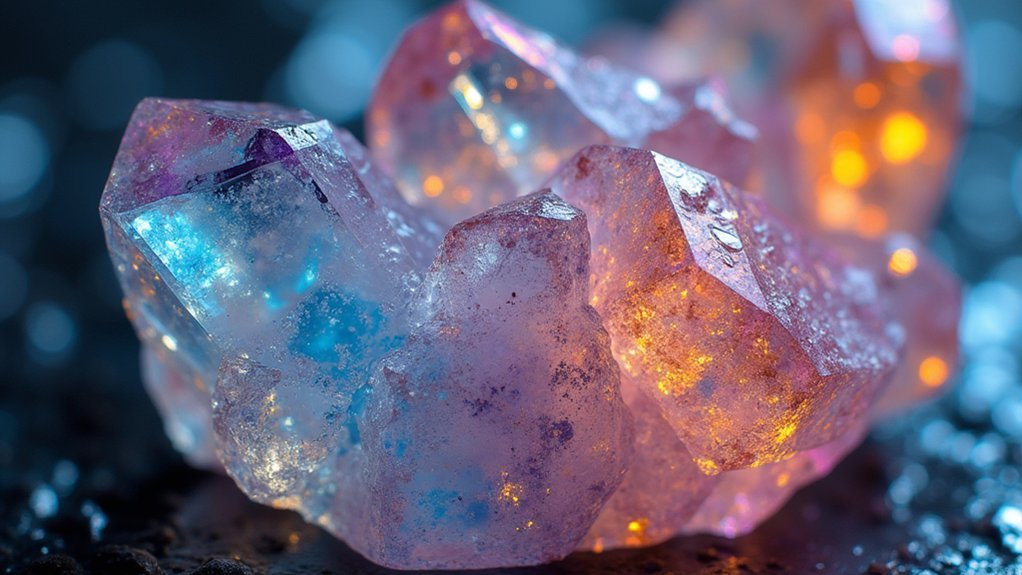
Despite their apparent beauty under normal lighting, crystals often conceal their most fascinating structural details until you deploy polarization techniques. By positioning two polarizing filters—one above your light source and another above the microscope tube—you’ll reveal vibrant colors and intricate patterns previously invisible to your camera.
Start with lower magnification (4X) before moving to higher power (40X) for detailed photographic images. As you rotate these filters, you’ll witness crystal structures transform dramatically, revealing their hidden architecture.
For maximum impact, position your specimens against a dark blue or black background, creating stark contrast that enhances visual appeal. You’ll also benefit from reduced glare and surface reflections, allowing your camera to capture true crystal colors and textures with unprecedented clarity and accuracy.
Lighting Systems That Enhance Crystal Transparency
While polarization techniques reveal crystal structure, proper lighting systems enhance their transparency. Specialized lighting systems create the ideal environment to showcase crystalline specimens in their full glory. You’ll need to master both light positioning and quality to achieve peak results.
- High-angle lighting combined with diffusing materials reveals translucency and depth that remain hidden under standard lighting.
- Multiple light positions eliminate unwanted reflections and shadows, making crystal faces more visible.
- Proper light temperature guarantees color fidelity across different specimens.
- Combining diffuse and direct light sources balances illumination to highlight both internal structures and surface features.
Focus Stacking Methods for Multi-Faceted Specimens
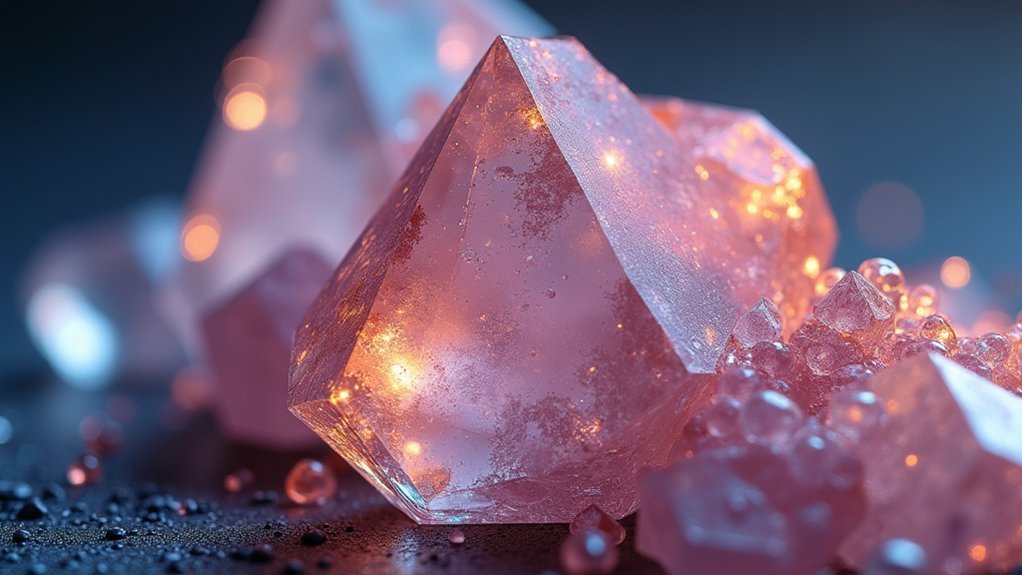
Because crystalline specimens feature multiple intricate facets at varying depths, conventional photography fails to capture their full complexity in a single shot.
You’ll need to master focus stacking techniques that combine multiple images taken at different focal points to achieve exceptional depth of field.
Begin by capturing a series of raw images with focus adjustments less than 1 degree apart. This guarantees every intricate detail remains sharp throughout your specimen.
Use a remote camera release to eliminate vibrations that could compromise image quality at such close range.
For processing, software like Helicon Focus lets you fine-tune raw image development settings and select ideal rendering methods.
Consider adding a polarizing filter to your setup—it enhances color vibrance and reveals patterns that might otherwise remain hidden in your crystalline subjects.
Digital Post-Processing for Scientific Accuracy
Since scientific integrity hinges on accurate representation, your digital post-processing workflow must prioritize fidelity over artistic enhancement.
When working with crystalline specimens, techniques like focus stacking and color correction aren’t merely aesthetic choices but scientific necessities.
For best results in your digital post-processing:
- Capture in RAW format to preserve maximum data for later adjustments
- Use specialized software like Helicon Focus for stacking multiple focal planes
- Apply color correction with scientific calibration tools to guarantee true representation
- Document your post-processing steps for scientific reproducibility
Remember to properly catalog your processed images with detailed labels that include specimen information and processing methods.
This meticulous approach guarantees your crystallography work maintains scientific value while showcasing the intricate textures and translucency that make these specimens so remarkable.
Mounting Solutions to Minimize Vibration and Reflection
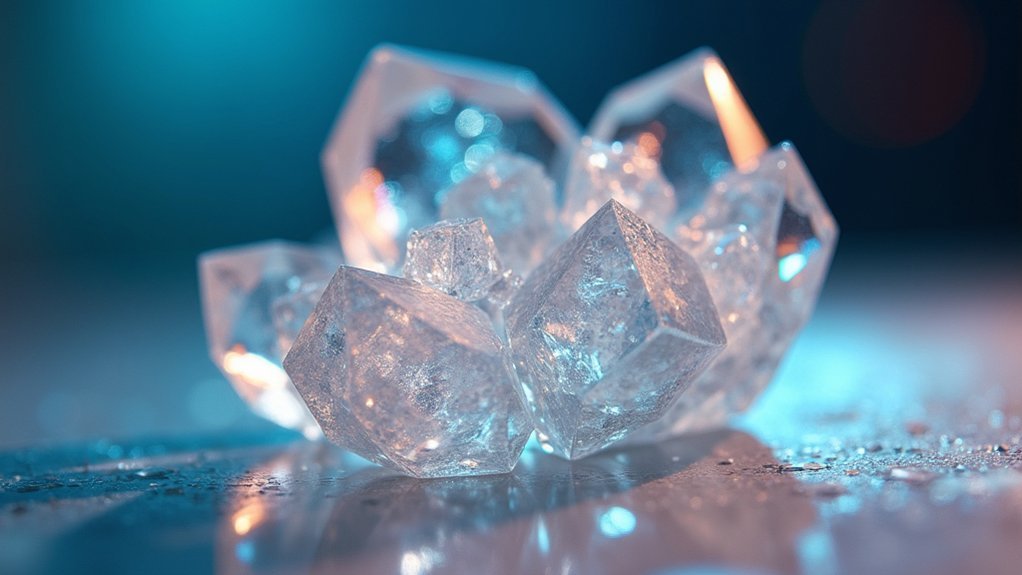
Even the most advanced camera can’t compensate for physical movement during crystal photography.
You’ll achieve the best results by investing in a heavy tripod that dramatically reduces vibrations, allowing for superior detail capture. Consider bolting your photography table to a wall for enhanced stability—vital when working with delicate mineral specimens.
Your camera’s mirror lock-up feature prevents camera shake during critical exposure moments, while a rubber bulb release eliminates vibration transfer from your hands to the equipment.
For peak focus without vignetting, extension tubes are invaluable tools in your arsenal.
Remember to maintain proper white balance when setting up your mounting solutions, as reflections can alter the perceived color and clarity of crystalline structures.
These mounting techniques guarantee your specimens appear exactly as they should—pristine and detailed.
Frequently Asked Questions
What Is the Most Common Form of Photography Used Today?
Digital photography is the most common form you’ll encounter today. It’s largely replaced traditional film due to its convenience, immediate results, and accessibility through smartphones with high-quality cameras and editing software.
What Was the Significance of Photography Invention?
Photography’s invention revolutionized how you document reality. It captured life with unprecedented accuracy, transformed art, enabled scientific documentation, and preserved personal history. It’s changed your world by making visual records permanent and accessible.
How Do You Think Photography Will Evolve in the Near Future With the Advent of New Technology and Advancements in AI?
You’ll see AI-enhanced cameras automating image corrections while computational photography captures scenes that were impossible before. AR tools will guide your composition, and machine learning will instantly optimize your shots for stunning results.
How Can Photography Be Used as a Tool for Social Change?
You can use photography to expose injustice, tell marginalized stories, and amplify voices for change. By creating powerful, emotional images that resonate with viewers, you’re building empathy and mobilizing action around social causes.
In Summary
You’ll find that capturing crystalline specimens requires a deliberate approach combining specialized equipment and techniques. As you’ve seen, everything from your lens choice to lighting setup impacts how accurately you’ll represent these complex structures. By investing in proper polarization tools, mastering focus stacking, and utilizing appropriate mounting systems, you’ll create images that aren’t just visually striking but scientifically valuable for research, identification, and preservation.

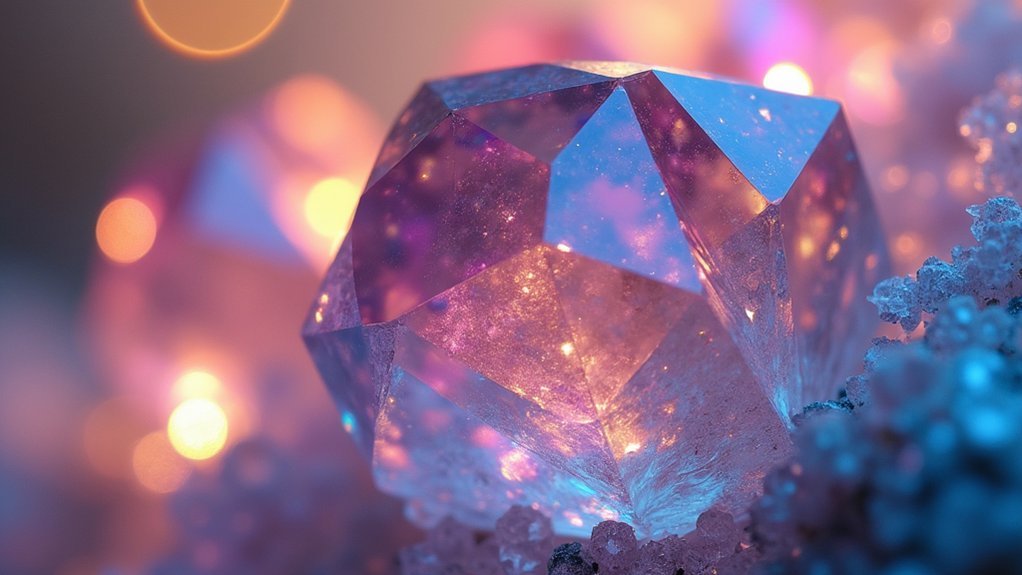



Leave a Reply